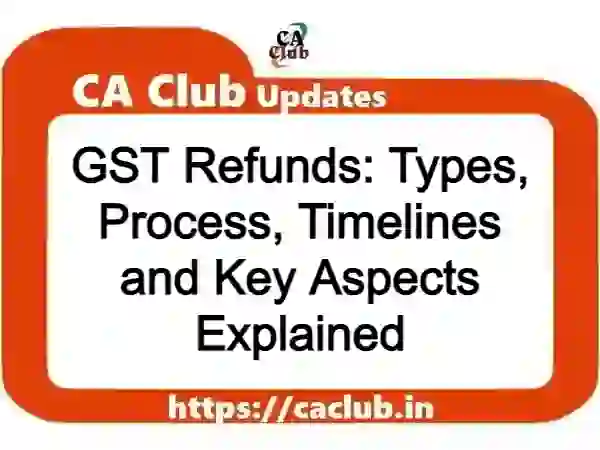The Goods and Services Tax (GST) regime aims to streamline and standardize refund procedures to ensure timely release of blocked working capital for taxpayers. The GST law has laid down specific provisions and timelines for processing of refund claims through a technology driven automated process with minimal human intervention.
Situations Leading to Refund Claims
As per Section 54 of the CGST Act, 2017, the following situations may warrant a refund claim:
– Exports and supplies to SEZs (zero rated supplies)
– Inverted duty structure
– Excess payment of tax
– Purchase by UN bodies and embassies
– Finalization of provisional assessment
– Pre-deposit refund
– Deemed exports
– Refund on account of judgment or court order
Key Features of GST Refund Process
– Zero rated supplies like exports and SEZ supplies are allowed to claim refund of accumulated input tax credit without payment of tax by furnishing a Bond/Letter of Undertaking (LUT).
– 90% provisional refund is granted within 7 days of acknowledgement of claims related to zero rated supplies.
– Refund can be claimed if tax paid in wrong head (IGST instead of CGST+SGST and vice versa).
– Unjust enrichment test applied to ensure tax incidence not passed on to consumer.
– Standardized procedure for making refund claims online in FORM GST RFD-01.
– Deficiencies, if any, to be communicated within 15 days and claim re-submitted post rectification.
– Claim to be sanctioned within 60 days of filing through FORM GST RFD-06 else interest payable.
– Key document is statement of invoices, not actual invoices.
– Bank account details required for direct e-payment of sanctioned refund amount.
– Opportunity of being heard before rejection.
– Single authority for disbursal of sanctioned refund.
Important Refund Related Provisions
Zero Rated Supplies
– Exporters can claim refund of accumulated input tax credit without payment of integrated tax by furnishing a Bond/LUT.
– 90% provisional refund released within 7 days of acknowledgement of claim.
Payment of Wrong Tax
Refund can be claimed if tax paid in wrong head (IGST instead of CGST+SGST and vice versa).
Compliance with Principles of Natural Justice
– Notice in FORM GST RFD-08 required before rejection.
– Opportunity to respond within 15 days from receipt of notice.
Standardized Procedure
– Online filing of refund claims in FORM GST RFD-01.
– Deficiencies to be communicated in 15 days.
– Claim re-submitted post rectification treated as fresh refund claim.
– Time excluded for calculation of limitation period.
Documentation
– Statement of invoices sufficient, not actual invoices.
– Bank realisation certificate required for refund of export of services.
– Self-declaration required for claims below Rs. 2 lakhs.
– CA certificate required for claims above Rs. 2 lakhs.
Payment to be Credited Online
– Direct e-payment of sanctioned refund amount into bank account.
Important Refund Types
Refund of Exports and Supplies to SEZs
– Shipping bill deemed to be refund application for IGST on exports.
– Refund claim to be filed online in FORM GST RFD-01.
– Refund of IGST on exports processed by customs.
Refund of Inverted Duty Structure
– Filed tax period wise in FORM GST RFD-01.
– Valid GSTR-1 and GSTR-3B return filing required.
– Net ITC covers credit on all inputs irrespective of tax rate.
Refund of Deemed Exports
– Supplier or recipient can file refund claim along with required documents.
– Statement 5B of FORM GST RFD-01 required.
Refund of Unutilised ITC
– Filed online in FORM GST RFD-01.
– ITC debited from electronic credit ledger.
Refund for Casual/Non-resident Taxable Persons
– Excess advance tax paid at time of registration.
– Refund after filing all returns for registration period.
Recent Changes and Clarifications
– Clarification on calculation of refund amount.
– Clarification on receipt of export proceeds in special INR Vostro account.
– Amendment for calculating Net ITC for inverted duty refund.
– Refund to be granted on basis of GSTR-2B.
– Procedure prescribed for refund by unregistered persons.
– Manner of re-credit of erroneous refund in electronic credit ledger.
Conclusion
The GST law aims to simplify and standardize refund procedures for timely sanction and disbursal of eligible refund amounts to taxpayers through a technology driven automated process. Proper compliance with the prescribed procedures and timelines is essential for smooth processing of refund claims.
CBIC Information Brochure on GST Refunds (Nov. 2023)
